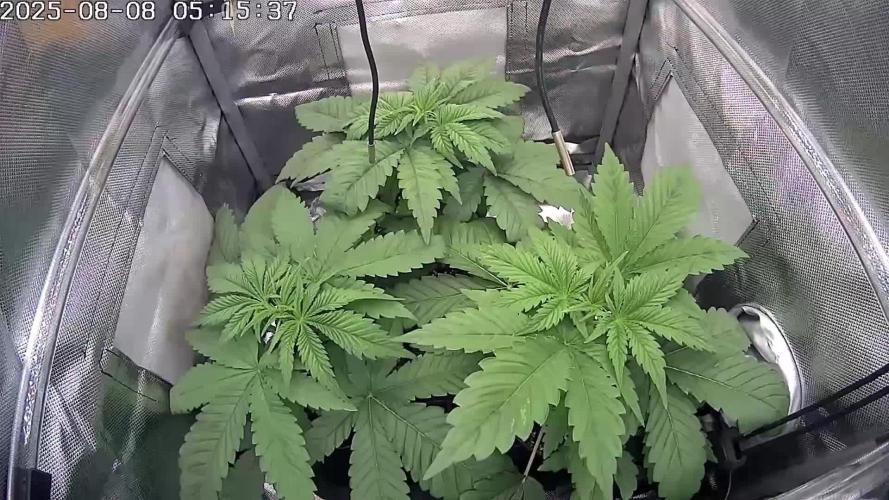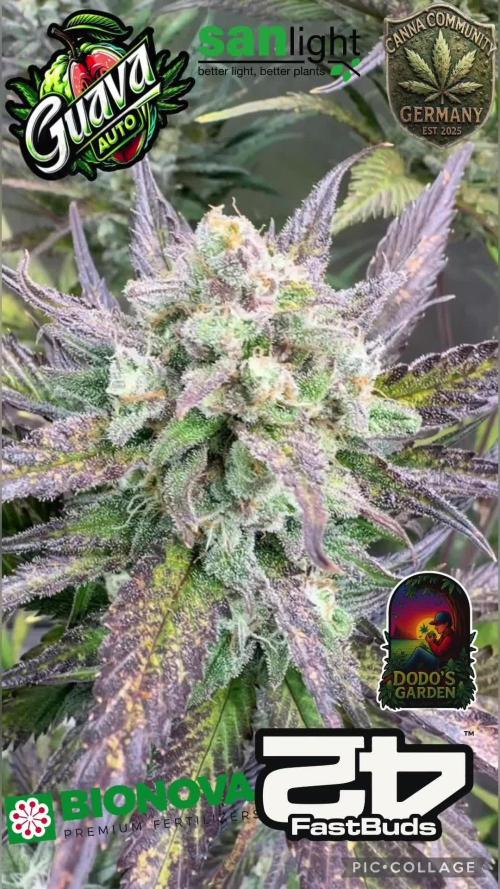The Grow Awards 2026 🏆 



































Likes
Comments
Share


@DarbGrowDiaries
Follow
This will be a bit of a challenge, one of the LCC is 45cm while the others are 25cm.
I gave them little ramps to keep canopy even and all 3 are still looking healthy.
Likes
30
Share


@ButterfliesLittleFarm
Follow
Hello Diary.
We came to the last week of vegetation, and we enter slowly into flowering.
Watermelon has grown 36 cm and looks healthy and satisfied.
This week I added a lot of nutrients when watering, I will see how they will react to that.
Her roommates, two Purple Punch outgrew her in height so I had to adjust the lights a bit to everyone at “Farm”. The lights are dimmed at 80%
The temperature in the growbox is around 25 degrees, which is ideal for me but the humidity is a bit lower than I would have liked. I'm thinking of putting on a humidifier again.
The plants started to be more thirsty so now watering is more frequent as well.
Let’s take a look at the review of the week.
10/02/2021 - Day 15.
Watering. p.H I adjusted to 6.3 with Lemon Kick and added one Easy Grow tablet to 6 liters of water. With that, I watered all three plants evenly.
Temp / Humidity on the farm - 24.5 degrees and 40% humidity.
13/02/2021 - Day 18.
Watering.p.H I regulated to 6.4 and did not add any other nutrients.
Temp / Humidity on the farm - 24.3 degrees and 40% humidity.
16/02/2021 - Day 21.
Photographing and watering. This time I added CalMg, 1.5ml / L preventively and from BoiBizz I added Bio Heaven, Bio Grow, Acti Vera and Alg-A-Mix only 2ml / L each. p.H I regulated at 6.4. Due to the low humidity, I put the humidifier back in the GrowBox.
Temp / Humidity on the farm - 24 degrees and 35% humidity.
That’s it for this week, thanks to everyone who stop by and take a look. See you soon.
Likes
19
Share


@Gruenerfinger85
Follow
Heute habe ich meine Girls ein 2 mal getoppt, und einwenig entlaubt. Vor 2 Tagen habe ich von jeder Pflanze 2 Stecklinge entnommen da das Wachstum sehr gut ist, und sie mit dem Stress gut zurecht kommen, bis jetzt zeigen sie keine Mangelerscheinungen. Futter gab es heute nur einwenig da ich sie nicht übersättigen will.
Ich werde sie ein drittes mal toppen wenn meine Girls in den nächsten Tagen keine stress Symptome anzeigt.
Processing
Likes
8
Share


@Greenbean15
Follow
Added the other two bag seeds in this week. They aren’t stretching quite yet. Pineapple Express is stretching like crazy and is now the tallest plant in the tent.
Put the ScrOG net in to help control the grow... I have five plants in the flowering tent and the tent is only 2x4... defoliated each plant this week... lets see how this grows 😅
Likes
4
Share


@OHighOBoyz
Follow
Hard to believe in about a month these buds will be getting smoked. That’s gonna be such a rewarding feeling as a first time grower.plant is just stacking up on bud size it’s insane to watch
Likes
12
Share


@L_Choppa
Follow
This girl is about finished here sister came out to about a 1 1/2 ounce hopefully this big girl is more overall good experience I don't have to say I will be doing these again because I already have 2nd and 3rd generation clones who am I tho I. Just a newbie 😌 lol
Likes
12
Share


@Ieiogrow94
Follow
Eccoci qui...
Per problemi di lavoro ho tardato un pò la pubblicazione delle foto, la piccola è molto vigorosa ed emana un forte odore.. Già si può vedere la resina che si inizia a formare sulle cime in alto...
La più alta del box anche se, credo non faccia cime giganti, sono molto contento che ha questo colore viola intenso nelle foglie, spero in un fenotipo più violaceo...
Grazie a tutti per il supporto, NON VEDO L'ORA DI RACCOGLIERLA 🔥🌲❤️
Likes
142
Share


@MadeInGermany
Follow
Hi everyone :-)
This week a lot of nice things happened in the flower tent :-)
Everyone looks super nice, and is growing stronger and more beautiful week by week 😍👌.
The blue cheese smells like a dream ;-) As usual from this variety 👍.
The kosher tangie is also very, very tasty 👏🏻.
Both got Pk 13/14 this week for the last time :-)
Everyone else is developing very well 👍, That will be the last diary with several strains together :-)
In future everyone will come individually 👌.
I wish you a lot of fun with the videos, have a nice weekend, stay healthy 🙏🏻 and let it grow 😎👌
Likes
2
Share


@TTerpz
Follow
Start of week 12: 4/29/25
Fed with nutrients: 4/29/30
Fed with plain ph water : 4/30/25
Fed with nutrients: 5/2/25
Fed with ph water: 5/5/25
End of week 5/5/25
Likes
11
Share


@GREENPHOENIX6262
Follow
*Week 5 Flower 09/24*
Thus far both both plants are flowering and budding nicely, Trichomes are setting in accordingly, Increase in Phosphate and Potassium nute feeds.
Both plants have appeared to stop growing in height settling in at 48Inches.
Top COLAS are pretty dense and the aroma coming off both of them is bright and vibrant
White Hairs are starting to turn bright orange.
*Week 5 Flower Mid week update - 09/28*
Both plants have reached max height (48 Inches)
Bud sites are filling up and have become more dense with trichomes cover through the flowered bud.
60% orange hair coverage - Nearing harvest
*Week 5 Flower End week recap 09/30*
Both Apple Fritter and Critical+2.0 nearing harvest
Cutting back on nute feeds starting tomorrow and will increase clean water feeds
Flushing will begin in a week - both will be harvested in 2 weeks.
Likes
7
Share


@Salokin
Follow
Yesterday she was cut, run off ppms had been at zero for at least 4 days. For what this plant went through in terms of heat and humidity, I believe the outcome of roughly a kg wet is not too bad. Bud have a certain density to them but far away from what I prefer. However the presents of an abundance of Reepes is undeniable. ATM she smells very sweet with a hint of Creme and a bit of pine. She must be quite mold resistant, as the other plant in the tent with her was quite mold riddled and the Afghan didn’t catch anything in that tiny growspace.
Likes
15
Share


@SmokyPinball
Follow
Growth in early flower stage looks good. Plenty of bud sites. Nutes and LST, then major defoliation in one week.
Likes
Comments
Share


@AlpenZilla
Follow
🗓️ Veg – Week 3 ✅
This week was a small milestone:
✔️ All three plants were topped
✔️ Lower shoots removed (light lollipopping)
✔️ Transplanted into the final 15L fabric pots – and wow, root development was much further along than expected!
Likes
Comments
Share


@ChewiesGrow420
Follow
Got a few more of these seeds I’ll be growing more soon. Hopefully this next run will go better. As I have more experience under my belt.
Likes
34
Share


@Gorrilla420
Follow
Had few issues this week with slugs and rabbits in this new spot. It’s shot up since she got put in ground, gave her a good feed with grow and plants of water as we’ve had good 2 weeks without rain so ground was bone dry. See how this week goes, if good growth and not been attacked will start to train her out abit.
All for this week happy growing 🌱
Likes
11
Share


@Farmer1
Follow
It blooms quite quickly,Many trichomes are already appearing.beautiful color of the leaves It'll go pretty fast from now on.
Likes
1
Share


@Homegrownnyc
Follow
No last just pulling some leaves it’s a nice plant it grows very firm and strong. No lst even needed
Likes
15
Share


@Ciore
Follow
La verdad que no puedo decir Nada en negativo sobre esta chepa para mi Royal Queen Seeds es unos de Los mejores Banco de semilla por un error mio la sourdiesel se quedó pequena, però ha hecho su trabajo muy bien y a sido fuerte a resisti mi error.
💯💯💯💯💯💯Royal Queen Seeds























